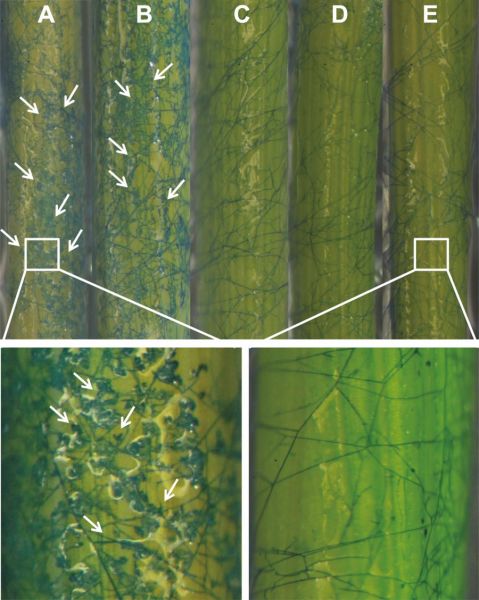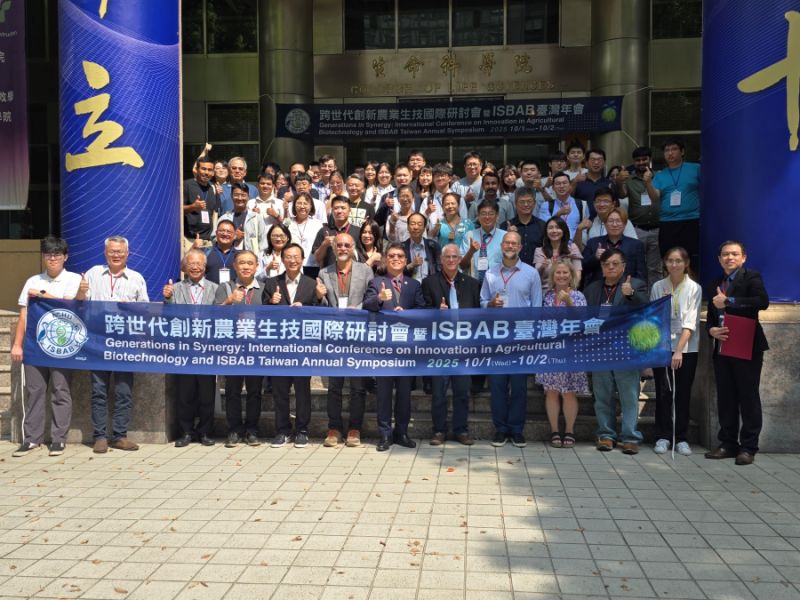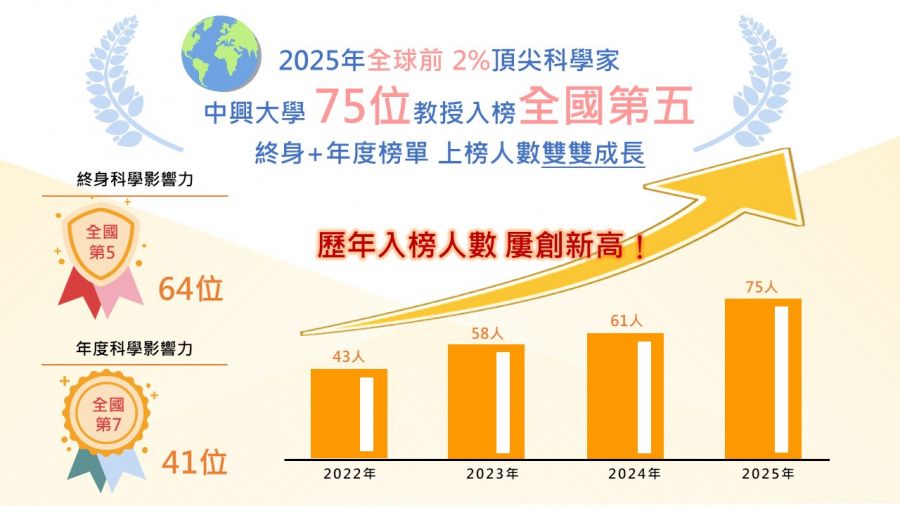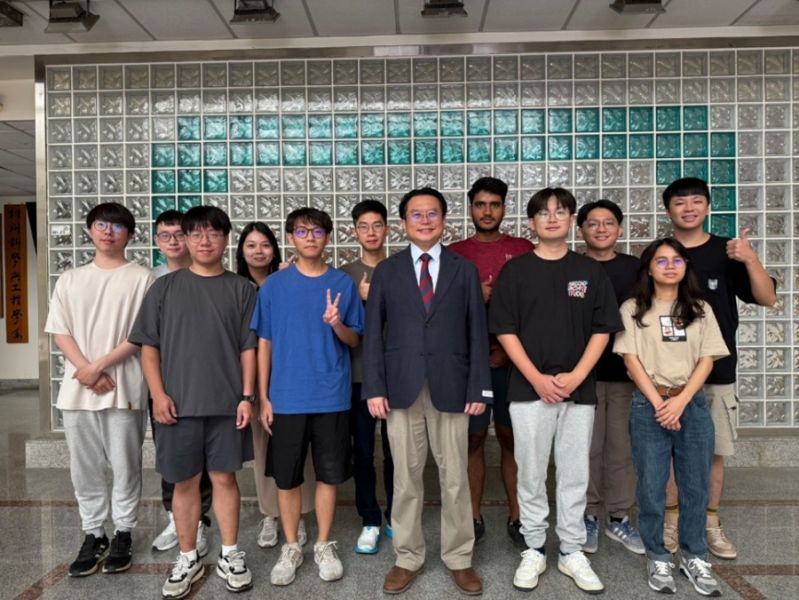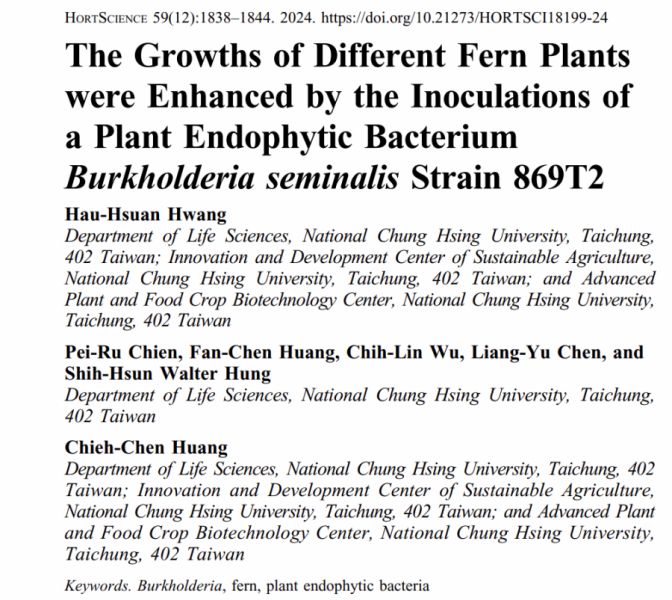新穎材料農業:農業新穎材料在植物保健開發、應用與機理【植物病理學系/黃姿碧副教授】
| 論文篇名 | 英文:Field sanitation and foliar application of Streptomyces padanus PMS-702 for the control of rice sheath blight 中文:應用Streptomyces padanus PMS-702作為田間衛生管理及葉噴生物資材防治水稻紋枯病 |
| 期刊名稱 | The Plant Pathology Journal |
| 發表年份,卷數,起迄頁數 | 2021, 37(1), 57-71 |
| 作者 | Yang, Chia-Jung; Huang, Tzu-Pi(黃姿碧)*; Huang, Jenn-Wen(黃振文) |
| DOI | 10.5423/PPJ.OA.12.2020.0227 |
| 中文摘要 | 由病原菌Rhizoctonia solani Kühn AG1-IA所造成之水稻紋枯病為水稻的重要病害之一,本研究的主要目的在於嘗試開發可做為田間衛生管理及葉噴應用之生物防治資材,祈有效減少水稻紋枯病的發生。研究結果發現稠李鏈黴菌Streptomyces padanus PMS-702所產生之二次代謝物治黴色基素(Fungichromin)可顯著抑制水稻紋枯病菌的菌絲生長,於3.07 mg/L能夠抑制50 %菌絲生長,並可造成菌絲原生質滲漏及抑制病原菌形成侵入構造。利用麥芽抽出物-苜蓿種子粉培養液培養S. padanus PMS-702,可使治黴色基素的產量達到802 mg/L。在混有紋枯病菌的稻稈田土中施用0.5 % (v/v) PMS-702發酵液,可加速病原菌死亡及減少病原菌於稻稈中的存活。另研究發現PMS-702發酵液配合0.5 % (w/v)苦茶粕施用後,可使土壤中帶菌稻稈之菌絲完全死亡,施用三週後亦可顯著降低紋枯病菌核發芽率。此外,利用黃豆粉-葡萄糖培養液(SMGC-2)培養S. padanus PMS-702製成SMGC-2發酵液與2 % (w/v)茶皂素溶液以體積一比一混合製成SPT製劑後,進行水稻紋枯病防治試驗,結果發現SPT製劑之100倍稀釋液可降低水稻紋枯病的罹病度。綜合上述結果證明稠李鏈黴菌PMS-702之發酵液可顯著防治水稻紋枯病的發生,另藉由配方之調整亦可提升此微生物製劑對水稻紋枯病的防治效用。 |
| 英文摘要 | Rice sheath blight (ShB), caused by Rhizoctonia solani Kühn AG1-IA, is one of the destructive rice diseases worldwide. The aims of this study were to develop biocontrol strategies focusing on field sanitation and foliar application with a biocontrol agent for ShB management. Streptomyces padanus PMS-702 showed a great antagonistic activity against R. solani. Fungichromin produced by S. padanus PMS-702, at 3.07 mg/l inhibited 50% mycelial growth, caused leakage of cytoplasm, and inhibited the formation of infection structures of R. solani. Fungichromin could reach to 802 mg/l when S. padanus PMS-702 was cultured in MACC broth for 6 days. Addition of 0.5% S. padanus PMS-702 broth into soil decreased the survival rate of the pathogen compared to the control. Soil amended with 0.5% S. padanus broth and 0.5% tea seed pomace resulted in the death of R. solani mycelia in the infested rice straws, and the germination of sclerotia was inhibited 21 days after treatment. Greenhouse trials revealed that S. padanus cultured in soybean meal–glucose (SMGC-2) medium after mixing with different surfactants could enhance its efficacy for inhibiting the pathogen. Of six surfactants tested, the addition of 2% tea saponin was the most effective in suppressing the pathogen. S. padanus broth after being fermented in SMGC-2, mixed with 2% tea saponin, diluted 100 fold, and sprayed onto rice plants significantly reduced ShB disease severity. Thus, S. padanus PMS-702 is an effective biocontrol agent. The efficacy of S. padanus PMS-702 for disease control could be improved through formulation. |
| 發表成果與本中心研究主題相關性 | 本研究開發具永續農業循環應用之水稻紋枯病生物防治資材,研究中証實Streptomyces padanus PMS-702微生物製劑具防治水稻纹枯病的功效,同時研究中已成功開發適宜作為田間衛生管理及葉噴防治應用的菌株培養養配方,研究中也發現藉由搭配農業廢棄物如:苦茶粕之介質添加,有助提升其病害防治效力。 |
圖一、治黴色基素對於水稻紋枯病菌形成入侵結構之影響。
Fig. 1 Effect of the fungichromin on the formation of infection structures by Rhizoctonia solani RS1-731. Rice seedlings were treated with distilled water (A), 0.1% (v/v) DMSO (B), 2 mg/l fungichromin (C), 5 mg/l fungichromin (D), or 10 mg/l fungichromin (E). Five-day-old rice seedlings in each treatment and mycelia of R. solani RS1-731 were co-cultured for 2 days, and then observed under dissecting microscope. White arrows indicated the lobated appressoria of the isolate RS1-731 on rice seedlings surface.

